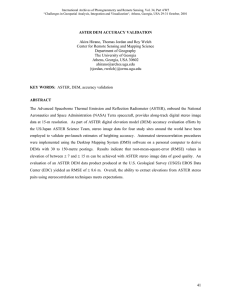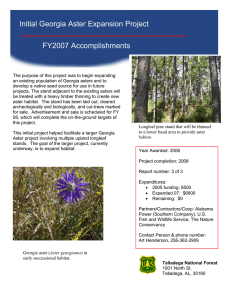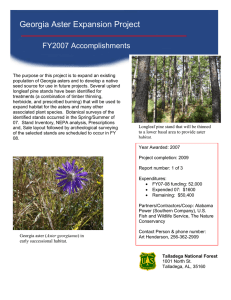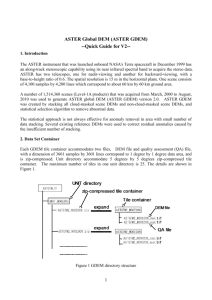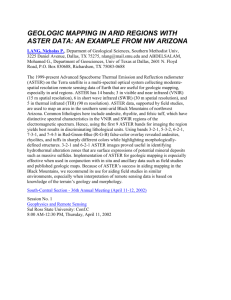ACCURACY ASSESSMENT OF ASTER GLOBAL DEM OVER TURKEY
advertisement
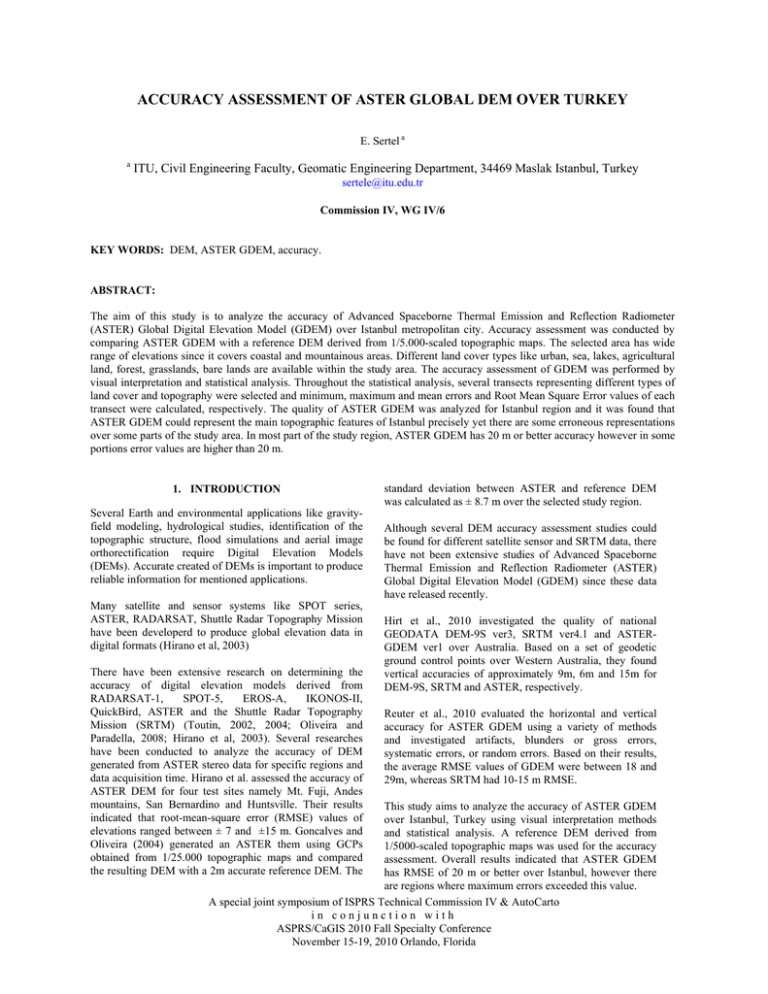
ACCURACY ASSESSMENT OF ASTER GLOBAL DEM OVER TURKEY E. Sertel a a ITU, Civil Engineering Faculty, Geomatic Engineering Department, 34469 Maslak Istanbul, Turkey sertele@itu.edu.tr Commission IV, WG IV/6 KEY WORDS: DEM, ASTER GDEM, accuracy. ABSTRACT: The aim of this study is to analyze the accuracy of Advanced Spaceborne Thermal Emission and Reflection Radiometer (ASTER) Global Digital Elevation Model (GDEM) over Istanbul metropolitan city. Accuracy assessment was conducted by comparing ASTER GDEM with a reference DEM derived from 1/5.000-scaled topographic maps. The selected area has wide range of elevations since it covers coastal and mountainous areas. Different land cover types like urban, sea, lakes, agricultural land, forest, grasslands, bare lands are available within the study area. The accuracy assessment of GDEM was performed by visual interpretation and statistical analysis. Throughout the statistical analysis, several transects representing different types of land cover and topography were selected and minimum, maximum and mean errors and Root Mean Square Error values of each transect were calculated, respectively. The quality of ASTER GDEM was analyzed for Istanbul region and it was found that ASTER GDEM could represent the main topographic features of Istanbul precisely yet there are some erroneous representations over some parts of the study area. In most part of the study region, ASTER GDEM has 20 m or better accuracy however in some portions error values are higher than 20 m. 1. INTRODUCTION Several Earth and environmental applications like gravityfield modeling, hydrological studies, identification of the topographic structure, flood simulations and aerial image orthorectification require Digital Elevation Models (DEMs). Accurate created of DEMs is important to produce reliable information for mentioned applications. Many satellite and sensor systems like SPOT series, ASTER, RADARSAT, Shuttle Radar Topography Mission have been developerd to produce global elevation data in digital formats (Hirano et al, 2003) There have been extensive research on determining the accuracy of digital elevation models derived from RADARSAT-1, SPOT-5, EROS-A, IKONOS-II, QuickBird, ASTER and the Shuttle Radar Topography Mission (SRTM) (Toutin, 2002, 2004; Oliveira and Paradella, 2008; Hirano et al, 2003). Several researches have been conducted to analyze the accuracy of DEM generated from ASTER stereo data for specific regions and data acquisition time. Hirano et al. assessed the accuracy of ASTER DEM for four test sites namely Mt. Fuji, Andes mountains, San Bernardino and Huntsville. Their results indicated that root-mean-square error (RMSE) values of elevations ranged between ± 7 and ±15 m. Goncalves and Oliveira (2004) generated an ASTER them using GCPs obtained from 1/25.000 topographic maps and compared the resulting DEM with a 2m accurate reference DEM. The standard deviation between ASTER and reference DEM was calculated as ± 8.7 m over the selected study region. Although several DEM accuracy assessment studies could be found for different satellite sensor and SRTM data, there have not been extensive studies of Advanced Spaceborne Thermal Emission and Reflection Radiometer (ASTER) Global Digital Elevation Model (GDEM) since these data have released recently. Hirt et al., 2010 investigated the quality of national GEODATA DEM-9S ver3, SRTM ver4.1 and ASTERGDEM ver1 over Australia. Based on a set of geodetic ground control points over Western Australia, they found vertical accuracies of approximately 9m, 6m and 15m for DEM-9S, SRTM and ASTER, respectively. Reuter et al., 2010 evaluated the horizontal and vertical accuracy for ASTER GDEM using a variety of methods and investigated artifacts, blunders or gross errors, systematic errors, or random errors. Based on their results, the average RMSE values of GDEM were between 18 and 29m, whereas SRTM had 10-15 m RMSE. This study aims to analyze the accuracy of ASTER GDEM over Istanbul, Turkey using visual interpretation methods and statistical analysis. A reference DEM derived from 1/5000-scaled topographic maps was used for the accuracy assessment. Overall results indicated that ASTER GDEM has RMSE of 20 m or better over Istanbul, however there are regions where maximum errors exceeded this value. A special joint symposium of ISPRS Technical Commission IV & AutoCarto in conjunction with ASPRS/CaGIS 2010 Fall Specialty Conference November 15-19, 2010 Orlando, Florida 2. STUDY AREA AND DATA 2.1 Study Area Istanbul lies over 28 and 29 East longitudes and 41 and 40 North latitudes with a total area of an area of 5.512 sq km. The city is divided by Istanbul Strait, which also divides Asian and European Continents. Istanbul has a population of approximately 12.5 Million and ranked as the 12nd largest city of the world (URL 1, 2010). Istanbul has wide range of elevations since it covers coastal and mountainous areas. Figure 1 shows the geographical location of Istanbul. corresponding to about 60 km-by-60 km ground area. Vertical accuracy is specified 95 % Confidence Level with 20 meters varying between 10 m and 25 m (URL 3, ASTER Validation Team 2009). Istanbul lies over 4 ASTER GDEM scenes namely; 1) ASTGTM_N40E028, 2) ASTGTM_N40E029, 3) ASTGTM_N41E028, 4) ASTGTM_N41E029. These for scenes were first combined then subsetted from the city boundary of Istanbul. ASTER DEM of Istanbul was resampled to 3 m in order to precisely compare the elevations values with Reference Istanbul DEM. Reference Digital Elevation Model was created using 1/5000-scaled digital topographic maps having 3 m grid size. Horizontal accuracy of these maps are better than 50 cm and vertical accuracy is approximately 1 m based on the degree of slope. The reference ellipsoid of 1/5000-scaled maps is GRS80. 3. QUALITY ASSESSMENT Quality assessment of ASTER GDEM was conducted by comparing these data with reference DEM generated from 1/5000 scaled topographic maps. Visual and statistical approaches were used for the quality assessment. 3.1 Visual Interpretation Figure 1. Study area Different land cover types like urban, sea, lakes, agricultural land, forest, grasslands, and bare lands are available within the city. It’s highest peak is Aydos Mountain (537 meter) in Kartal County. Istanbul’s shoreline has a lenght of 647 km. According to the Köppen climate classification system, Istanbul has a Mediterranean climate. Riva river is the largest river in Istanbul, about 71 km long originating at Kocaeli Peninsula and flows to the Black Sea at Beykoz county (URL 2, 2010). 2.2 Digital Elevation Models The Ministry of Economy, Trade, and Industry (METI) of Japan and the United States National Aeronautics and Space Administration (NASA) were jointly developed The Advanced Spaceborne Thermal Emission and Reflection Radiometer (ASTER) Global Digital Elevation Model (GDEM) to be available at no charge to users worldwide via electronic download from ERSDAC and from NASA’s Land Processes Distributed Active Archive Center (LP DAAC) (URL 3, 2010). Istanbul has elevation values ranging from 0 to 600 m since it has both coastal line and mountains within its boundary. It has six water basins where elevation levels are lower. Figure 2 shows ASTER GDEM and map-derived DEM of Istanbul. Visual interpretation of these DEMs showed that ASTER GDEM could capture the general topographic features of Istanbul like basins, drainage networks and lakes. The highest region in European side is Catalca and the highest peak in Asian side is Aydos and both of these regions could be identified from ASTER GDEM (Figure 2). Blue boxes within the figure 2 points out the location of water basins where elevations are lower. It seems that ASTER GDEM could capture these features. Northern and southern parts of Istanbul are covered with the Black Sea and the Marmara Sea, respectively. The elevation values in these parts are close to zero in ASTER GDEM as expected. ASTER GDEM has 15m horizontal spatial resolution where each scene consists of 4,100 samples by 4,200 lines, A special joint symposium of ISPRS Technical Commission IV & AutoCarto in conjunction with ASPRS/CaGIS 2010 Fall Specialty Conference November 15-19, 2010 Orlando, Florida elevation values. ASTER GDEM gave very similar results to the map derived data along this transect. The minimum, maximum and mean error values between reference DEM and ASTER GDEM were 0.01 m, 16.57 m and 4.56 m, respectively. Total RMSE value for this transect was calculated as 5.97 m. Figure 3. Location of Profile 1 and its elevation values Figure 2. ASTER GDEM (top) and map derived DEM (bottom) of Istanbul. Black boxes are located over mountainous areas; blue boxes are located over water basin areas. 3.2 Statistical Analysis Since 1/5000 scaled map derived DEM was created from aerial flights with approximately 1 m vertical accuracy these elevations were assumed as true during the comparisons. Minimum, maximum, mean and root mean square errors we calculated using equation 1, 2 ,3 and 4, respectively. Profile 2 was selected around the highest peak of Istanbul in the Asian part, which is Aydos Mountain with 537 m elevation (Figure 4). ASTER GDEM has significantly similar values to reference DEM values and the highest elevation value of Istanbul can be also identified using ASTER GDEM. There are two peaks over this region which are located 2100 m and 4500 m from the starting point of the transect. As can be seen in Figure 4, both peaks are clearly captured with ASTER GDEM. Elevation values of GDEM and reference DEM are also consistent between and outside the peaks. The minimum, maximum and mean error values between reference DEM and ASTER GDEM were 0.07 m, 24.48 m and 5.38 m, respectively. RMSE value was calculated as 7.38 m along this transect. In this study, ASTER GDEM elevation is represented with Z and map derived elevation is represented with Z*. Minimum Error = min(Z* -Z ) (1) Maximum Error= max(|Z* -Z |) (2) Mean Error=(|Z* -Z |)/n (3) RMSE=sqrt(|Z* -Z |)/n (4) n is the total number of points where elevations are extracted. Figure 4. Location of Profile 2 and its elevation values Profile 1 was selected throughout a riverbed close to the Black Sea coastline of the Anatolian side of Istanbul (Figure 3). The river itself can be identified between 3rd and 4th kilometer of the transect which can be easily identified from ASTER GDEM and reference DEM with their low Profile 3 was selected from the agricultural areas where the elevations are close to the sea level (Figure 5). These agricultural areas are located in Buyukcekmece water basin of Istanbul. There are also high open mining areas towards the western part of these agricultural areas. Profile 3 starts A special joint symposium of ISPRS Technical Commission IV & AutoCarto in conjunction with ASPRS/CaGIS 2010 Fall Specialty Conference November 15-19, 2010 Orlando, Florida from the open mining areas and goes along to the agricultural areas. It was found that ASTER GDEM represented the elevations of both high mining areas and lower agricultural fields very precisely. This transect lies over an elevation range of 10 m to 210 m and ASTER GDEM has compatible results over this region. The minimum, maximum and mean error values between reference DEM and ASTER GDEM were 0.01 m, 26.22 m and 3.04 m, respectively. RMSE value was calculated as 4.32 m along this transect. Total RMSE of this transect was the best among all other transects. Figure 6. Location of Profile 4 and its elevation values Figure 5. Location of Profile 3 and its elevation values Another profile was selected over Catalca Mountains, where is the highest region of the European side of Istanbul (Figure 6). Comparisons made between reference DEM and ASTER GDEM showed that although elevations of most part of this region represented correctly with ASTE GDEM there were some regions which had 50 m elevation difference. Profile 5 was selected over an industrial area where buildings are not high with only two floors. Eastern part of this industrial land is covered with forest area. The elevation values obtained from ASTER GDEM and reference DEM are illustrated in figure 7. There are also two identifiable roads inside the forested area which can be seen on 3400 m and 4050 m from the beginning of the transect. These roads have lower elevation values and ASTER GDEM could capture these values as can be seen in figure 7. In most part of this region, differences between map-derived and ASTER GDEM elevations are smaller than 20m. The minimum, maximum and mean error values between reference DEM and ASTER GDEM were 0.03 m, 40.88 m and 7.39 m, respectively. The maximum error was obtained over industrial area. Total RMSE value for this transect was calculated as 9.78 m. The minimum, maximum and mean error values between reference DEM and ASTER GDEM were 0.01 m, 50.60 and 11.42 m, respectively. Considering all data points collected from all transects, the highest maximum error was obtained in this region. On the other hand, total RMSE value was smaller than 20 m and calculated as 15.46 m along this transect. Figure 7. Location of Profile 5 and its elevation values Profile 6 was selected from the Terkos water basin of Istanbul European side where different ranges of elevation are available (Figure 8). This region is close to the Black Sea coastal line where also forest areas are available. The minimum, maximum and mean error values between reference DEM and ASTER GDEM were 0.01 m, 37.80 m A special joint symposium of ISPRS Technical Commission IV & AutoCarto in conjunction with ASPRS/CaGIS 2010 Fall Specialty Conference November 15-19, 2010 Orlando, Florida and 12.54 m, respectively. This transect hast the highest mean error value among the others, since there were more discrepancies between ASTER GDEM and reference DEM values. However, total RMSE of the transect was calculated as 15.21 m. Goncalves, J. A., Oliveira, A. M., 2004. Accuracy Analysis of DEMs Derived from ASTER Imagery, ISPRS XXth Congress, Istanbul. Hirano, A., Welch, R., Lang, H., 2003. Mapping from ASTER Stereo Image Data: DEM Validation and Accuracy Assessment. ISPRS Journal of Photogrammetry and Remote Sensing, 57, pp. 356– 370. Hirt, C. , Filmer, M. S. and Featherstone, W. E., 2010. Comparison and validation of the recent freely available ASTER-GDEM ver1, SRTM ver4.1 and GEODATA DEM-9S ver3 digital elevation models over Australia, Australian Journal of Earth Sciences, 57(3), pp.337 - 347. Oliveira, C.G., Paradella, W. R., 2008. An Assessment of the Altimetric Information Derived from Spaceborne SAR (RADARSAT-1, SRTM3) and Optical (ASTER) Data for Cartographic Application in the Amazon Region, Sensors, 8, pp.3819-3829. Figure 8. Location of Profile 6 and its elevation values 4. CONCLUSIONS The extracted elevation values from ASTER GDEM were compared with a more accurate map-derived DEM through visual interpretation and statistical analysis to determine the quality of ASTER GDEM over Istanbul, Turkey. Several transects were selected and statistical analyses were conducted for these transects. The results showed that ASTER GDEM could represent the main topographic features of Istanbul precisely yet there were some erroneous representations over some parts of the study area. In most part of the study region, ASTER GDEM has 20 m or better accuracy however in some portions of the region, error values are higher than 20 m since the maximum errors of 40 to 50 m were calculated. Considering the total RMSE values of each transect, ASTER GDEM has 20 m or better values based on the data used in this study. ACKNOWLEDGEMENTS Reuter, H. I., Nelson, A., Strobl, P., Mehl, W., Jarvis, A., 2009. A First Assessment Of Aster Gdem Tiles for Absolute Accuracy, Relative Accuracy and Terrain Parameters, IEEE International Geoscience and Remote Sensing Symposium. Toutin, T. H., 2002. Three-Dimensional Topographic Mapping with ASTER Stereo Data in Rugged Topography, IEEE Transactions on Geoscience and Remote Sensing, 40(10), pp. 2241-2247. Toutin, T.H., 2004. Comparison of Stereo - Extracted DTM from Different High- Resolution Sensors: SPOT-5, EROSA, IKONOS-II, and QuickBird. IEEE Transactions on Geoscience and Remote Sensing, 42(10), pp 2121-2129. URL 1, http://www.citymayors.com/ (accessed 20 August 2010) URL 2, Web page of Istanbul Metropolitan Municipality, http://www.ibb.gov.tr/ (accessed 1 September 2010). URL 3, Web page of he Land Processes Distributed Active Archive Center, https://lpdaac.usgs.gov/ (accessed 1 September 2010). The author would like to thank to METI and NASA for releasing free ASTER GDEM data. REFERENCES ASTER VALIDATION TEAM, 2009. ASTER global DEM validation summary report. ASTER GDEM Validation Team: METI, NASA and USGS in cooperation with NGA and other collaborators. http://www.lpdaac.usgs.gov4 (accessed 1 August 2010). A special joint symposium of ISPRS Technical Commission IV & AutoCarto in conjunction with ASPRS/CaGIS 2010 Fall Specialty Conference November 15-19, 2010 Orlando, Florida
